Hosted by Darren Baker
1/35 railway couplers
GregCopplin

Joined: September 06, 2011
KitMaker: 212 posts
Armorama: 201 posts

Posted: Saturday, December 08, 2018 - 08:39 AM UTC
Hi does anyone know where i could get some 1/35 railway couplers for dragons kommandowagen ?

Blaubar

Joined: December 15, 2016
KitMaker: 261 posts
Armorama: 246 posts

Posted: Saturday, December 08, 2018 - 08:52 AM UTC
Hi,
LZ Models do offer awesome couplings and stuff.
https://www.scalemates.com/kits/223478-lz-models-35308-wagon-couplings
Cheers,
/Stefan
LZ Models do offer awesome couplings and stuff.
https://www.scalemates.com/kits/223478-lz-models-35308-wagon-couplings
Cheers,
/Stefan
Kevlar06


Joined: March 15, 2009
KitMaker: 3,670 posts
Armorama: 2,052 posts

Posted: Saturday, December 08, 2018 - 08:54 AM UTC
Should be pretty easy to scratchbuild since European couplers are really just a "hook and loop" affair. They are kept in tension by the sprung bumper pads. Have you tried Marklin or LGB?
VR Russ
VR Russ

Chillidragon
Joined: September 20, 2012
KitMaker: 104 posts
Armorama: 70 posts
KitMaker: 104 posts
Armorama: 70 posts

Posted: Saturday, December 08, 2018 - 09:22 AM UTC
Not so simple. The basic Three Link Coupling you describe was only used on unfitted (i.e. lacking continuous brakes) freight; Screw couplings were used on fitted fast freight and passenger trains, with continuous brake, though yes, when tightened the buffers did provide springing to maintain tension. A compromise type (Instanter) was, AFAIK, only found in the UK, the other difference with the Continent being that, at that time, British companies mostly used Vacuum Brakes (as did BR post war, which I model - well, Summer 1969, anyway) and Continental railways used Air Brakes. I don't know when Buckeye or Knuckle Couplings came into use on the Continent, but I doubt they were fitted to military or freight vehicles if used at that time at all.

RobinNilsson

Joined: November 29, 2006
KitMaker: 6,693 posts
Armorama: 5,562 posts

Posted: Saturday, December 08, 2018 - 09:23 AM UTC

bottle screw in the middle to tighten the whole contraption.
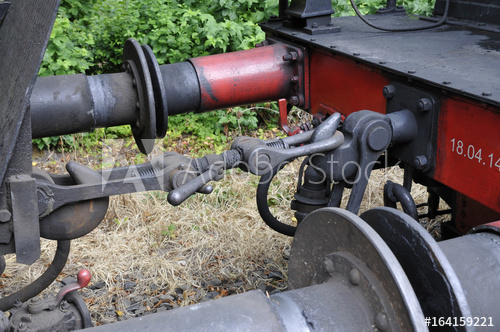
Slightly different ones

-------------------------------------------------------
Edit: Google found the image above for me but now that I located the webpage where it was included the German text says "Verzurrösen" which would be something like "lashing eyes/hooks" so it could be that they were used to tie down cargo (hooks go into chains and bolts on that waggon and the bottle screw pulls it tight).
End Edit
--------------------------------------------------------

One is in use, the other one hangs down on a separate hook.
Every waggon has couplings at both ends so there is "always" two couplers when two waggons are connected to each other.
If the one in use breaks, the spare is hanging ready ...
The design is from the early 20th century and is still in use, possibly upgraded for heavier loads by increasing the dimensions.
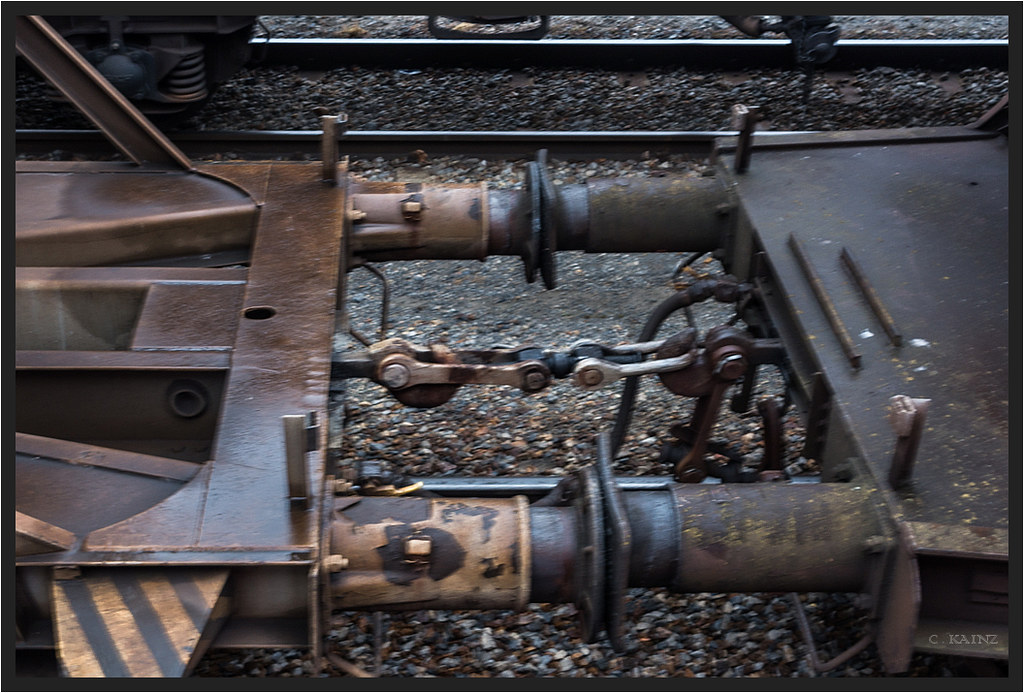
Most of the above are probably later than WW II but I think the principle has been the same for a long time.
Another thing to remember is that the bumpers are different.
On one side it is flat and the bumper on the other side is convex. Convex meets flat!
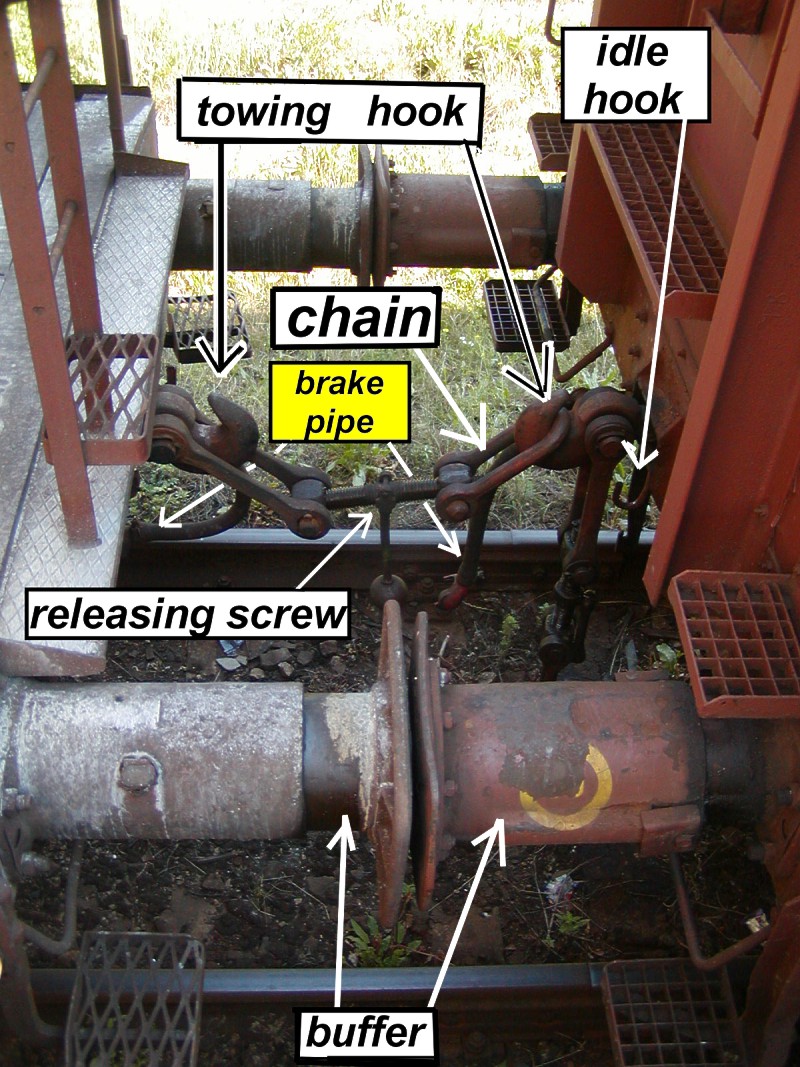
Image from the Railroad museum in Finland
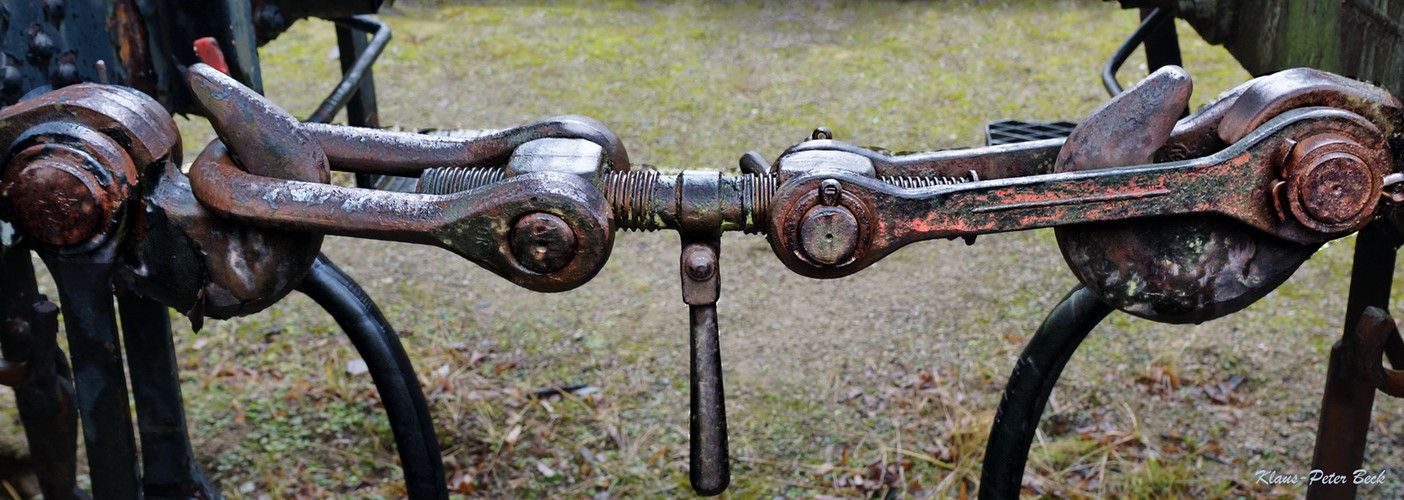
/ Robin

Chillidragon
Joined: September 20, 2012
KitMaker: 104 posts
Armorama: 70 posts
KitMaker: 104 posts
Armorama: 70 posts

Posted: Saturday, December 08, 2018 - 02:19 PM UTC
That's it! Ours differ only in that the fixed link is round and fits through a hole in the hook, like the other British types, rather than made of two flat sections bolted through the hook. I think I've seen that referred to as the Continental or RIV Coupling.
The detached examples, with hooks on each outer link, I've never seen before; any idea where, when, and how used?
The detached examples, with hooks on each outer link, I've never seen before; any idea where, when, and how used?
Posted: Saturday, December 08, 2018 - 05:07 PM UTC

RobinNilsson

Joined: November 29, 2006
KitMaker: 6,693 posts
Armorama: 5,562 posts

Posted: Saturday, December 08, 2018 - 08:19 PM UTC
Quoted Text
That's it! Ours differ only in that the fixed link is round and fits through a hole in the hook, like the other British types, rather than made of two flat sections bolted through the hook. I think I've seen that referred to as the Continental or RIV Coupling.
The detached examples, with hooks on each outer link, I've never seen before; any idea where, when, and how used?
Google found that image for me but now that I located the webpage where it was included the German text says "Verzurrösen" which would be something like "lashing eyes/hooks" so it could be that they were used to tie down cargo (hooks go into chains and bolts on that waggon and the bottle screw pulls it tight).
/ Robin

RobinNilsson

Joined: November 29, 2006
KitMaker: 6,693 posts
Armorama: 5,562 posts

Posted: Saturday, December 08, 2018 - 08:33 PM UTC
Quoted Text
That's it! Ours differ only in that the fixed link is round and fits through a hole in the hook, like the other British types, rather than made of two flat sections bolted through the hook. I think I've seen that referred to as the Continental or RIV Coupling. ......
Like this?
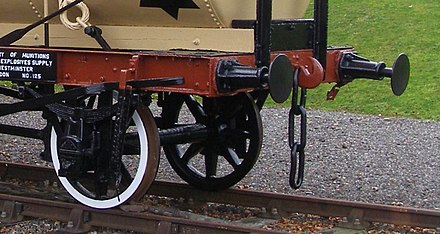
or like this?


"The coupling can still be used as a loose fit coupling or can be rotated to make it a close coupled connection. To do this the wagon brake is applied and the locomotive pushed up which compresses the buffers. Then the chain can be put over the hook and the center link easily rotated. When the locomotive releases the pressure the buffers release but not all the way as the chain is now much shorter and pulls tight. Because of the rounded shapes at the top of the Instanter it cannot rotate and keeps the link short. Now the rolling stock is close coupled and will not snap back and forth. In the drawing below you can see the Instanter in its rotated position with the rounded shapes at the top."
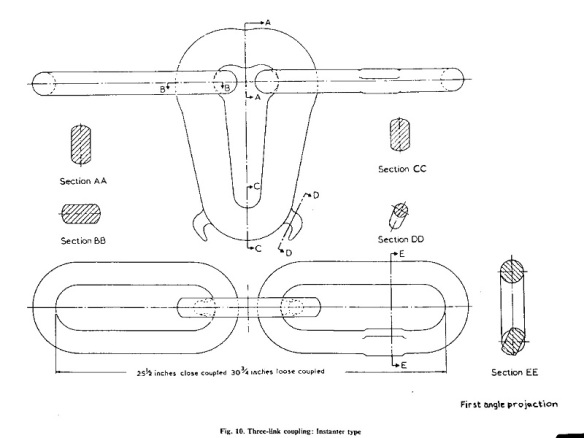
https://jamestrainparts.com/2017/03/13/oo-gauge-fixed-link-couplings-part-1/
Webpage with exploded view or assembly diagrams of various British couplings
https://www.cplproducts.net/couplings.html
/ Robin

GeraldOwens

Joined: March 30, 2006
KitMaker: 3,736 posts
Armorama: 3,697 posts

Posted: Saturday, December 08, 2018 - 11:21 PM UTC
Quoted Text
Hi does anyone know where i could get some 1/35 railway couplers for dragons kommandowagen ?
The Aber photo etch set includes some machined brass coupling parts.
http://www.aber.net.pl/detal,373.html
Set number 35 107

Chillidragon
Joined: September 20, 2012
KitMaker: 104 posts
Armorama: 70 posts
KitMaker: 104 posts
Armorama: 70 posts

Posted: Sunday, December 09, 2018 - 01:18 AM UTC
Quoted Text
Google found that image for me but now that I located the webpage where it was included the German text says "Verzurrösen" which would be something like "lashing eyes/hooks" so it could be that they were used to tie down cargo (hooks go into chains and bolts on that waggon and the bottle screw pulls it tight).
/ Robin
Ah! I should have recognised them as such - we also used them, on CONFLAT (container flat)wagons, to secure the load (RCH containers, not ISO) Worse yet - I have three etches full of the things.
You have shown all three of the 'classic' British couplings there; in order, Three Link, Screw, and Instanter.
Fiddly things in 1/76!

18Bravo

Joined: January 20, 2005
KitMaker: 7,219 posts
Armorama: 6,097 posts

Posted: Sunday, December 09, 2018 - 06:02 AM UTC
I took this one in the East back when I fancied myself a B&W photographer. (I hope to post some more on the Reconstruction thread.) It used to amaze me that the whole train was pulled and depended upon that one little link. I also wondered why the link wouldn't ride up the hook when the train slowed. I guess it just fell back into place due to the tension on the bumpers. Still, it always struck me as rather frail compared to US knuckle couplers.
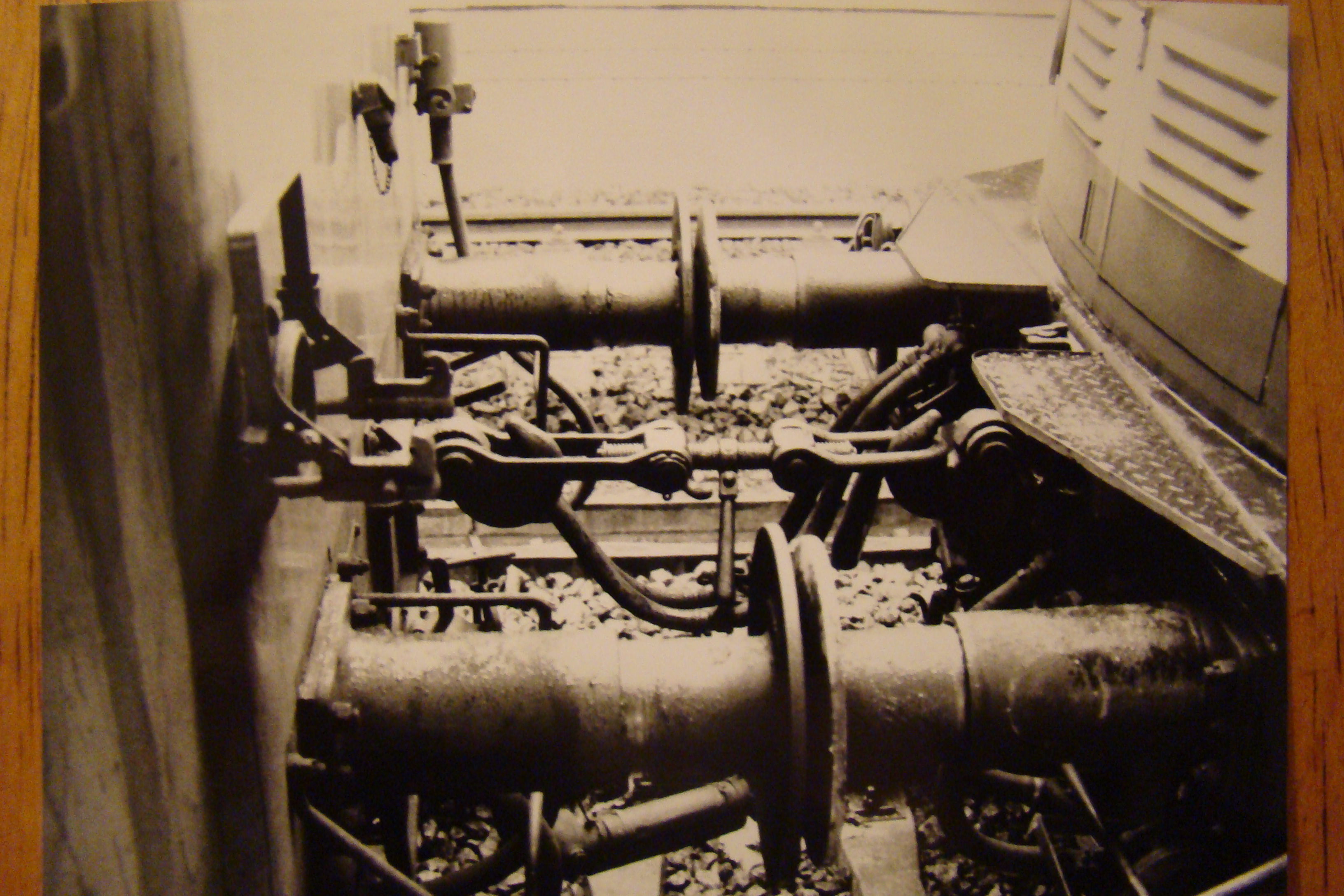


RobinNilsson

Joined: November 29, 2006
KitMaker: 6,693 posts
Armorama: 5,562 posts

Posted: Sunday, December 09, 2018 - 06:21 AM UTC
unhooking:
The chain is put in position when the bumpers/buffers are in contact. The bottle screw is turned to give the "chain" its maximum length. When the hook is in position the bottle screw is tightened. All the way I think ....
This compresses the springs inside the bumpers/buffers.
The bumpers/buffers are now under pressure. When the train enters a curve the innermost bumpers/buffers are compressed even more and the outer pair relaxes while still remaining in contact.
When pulling the cars through very tight curves, on industrial tracks and such, the coupling is loosened to allow more movement.
There is no chance whatsoever for the "chain" to get unhooked in normal operation of the train.
It happens that the chain brakes but the spare is hanging right there.
US knuckle couplers: Greater train weights in the US compared to Europe. Swedish iron ore trains use knuckle couplers.
Note that these also break and then the engineer/driver has to bring a new one all the way from the engine back to the
break in the train. In Europe the spare is hanging right there when it is needed
/ Robin
The chain is put in position when the bumpers/buffers are in contact. The bottle screw is turned to give the "chain" its maximum length. When the hook is in position the bottle screw is tightened. All the way I think ....
This compresses the springs inside the bumpers/buffers.
The bumpers/buffers are now under pressure. When the train enters a curve the innermost bumpers/buffers are compressed even more and the outer pair relaxes while still remaining in contact.
When pulling the cars through very tight curves, on industrial tracks and such, the coupling is loosened to allow more movement.
There is no chance whatsoever for the "chain" to get unhooked in normal operation of the train.
It happens that the chain brakes but the spare is hanging right there.
US knuckle couplers: Greater train weights in the US compared to Europe. Swedish iron ore trains use knuckle couplers.
Note that these also break and then the engineer/driver has to bring a new one all the way from the engine back to the
break in the train. In Europe the spare is hanging right there when it is needed

/ Robin
Kevlar06


Joined: March 15, 2009
KitMaker: 3,670 posts
Armorama: 2,052 posts

Posted: Sunday, December 09, 2018 - 07:18 AM UTC
In 1995, I was in charge of 6 railheads loading heavy equipment for Bosnia in Germany. I spent Christmas Eve and Christmas Day at the Guterbahnhof in Frankfurt with a team of volunteers because we had to open that railhead in downtown Frankfurt due to the ongoing French rail strike which backlogged the availability of schwere (heavy) transport cars. We operated that railhead for 4 days to free up rail traffic. It was surreal to be on this nearly abandoned railhead, in the middle of a snowstorm, surrounded by skyscrapers decked out in Christmas lights at midnight on Christmas Eve. I watched the DB switch men work each train being brought in, and marveled at their bravery when hooking those couplers up-- they would stand between the cars and swing the levers on those screws to loosen them as the switch engine applied pressure to the cars against the bumpers. What struck me most is the fact these guys could move so quickly between a string of cars. It's dangerous work-- the trainmaster on one of the trains spoke excellent English, and we had a discussion about that, at which point he pulled his right hand out of his pocket, pulled off his glove to show me the missing little finger and ring finger, and simply said "it doesn't always work out perfect".
VR, Russ
VR, Russ

KurtLaughlin

Joined: January 18, 2003
KitMaker: 2,402 posts
Armorama: 2,377 posts

Posted: Sunday, December 09, 2018 - 01:52 PM UTC
Quoted Text
It's dangerous work-- the trainmaster on one of the trains spoke excellent English, and we had a discussion about that, at which point he pulled his right hand out of his pocket, pulled off his glove to show me the missing little finger and ring finger, and simply said "it doesn't always work out perfect".
VR, Russ
A common injury on US railroads in the 19th Century, before automatic knuckle couplers were adopted. Switch men were given wooden paddles to hold the loops up (and to apply extra leverage before the use of air brakes) but many men refused to use them.
KL

KurtLaughlin

Joined: January 18, 2003
KitMaker: 2,402 posts
Armorama: 2,377 posts

Posted: Sunday, December 09, 2018 - 01:59 PM UTC
Quoted Text
US knuckle couplers: Greater train weights in the US compared to Europe. Swedish iron ore trains use knuckle couplers.
Note that these also break and then the engineer/driver has to bring a new one all the way from the engine back to the
break in the train. In Europe the spare is hanging right there when it is needed
Over here, if they got to the point of breaking so frequently that spares needed to be carried on every car I'm sure they would change the coupler design . . .
I've always maintained that the reason there aren't any 1/35 models of US WW II flatcars and track is that it would show a technology that was bigger and better than anything the Germans could come up with, and we can't have that!

KL

18Bravo

Joined: January 20, 2005
KitMaker: 7,219 posts
Armorama: 6,097 posts

Posted: Sunday, December 09, 2018 - 02:26 PM UTC
Kevlar06


Joined: March 15, 2009
KitMaker: 3,670 posts
Armorama: 2,052 posts

Posted: Monday, December 10, 2018 - 07:49 AM UTC
Quoted Text
https://www.youtube.com/watch?v=BhZMkr-Gl_c
This is exactly what I was referring to. Now imagine doing this in a snowstorm at night on a dimly lit railhead (although the engineer in the switcher was a little more careful about the speed he was traveling when I was there anyway). These are brave guys. I'd rather jump out of a perfectly good airplane than do this, day in and day out. I imagine during WWII it was even worse. I did note that when I watched these guys, they had three-way radio commo between the train master, engineer and the guy on the coupler.
VR, Russ
 |











